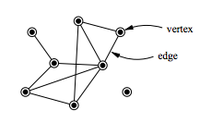
Photo from wikipedia
Design of allosteric regulators is an emergent field in the area of drug discovery holding promise for currently untreated diseases. Allosteric regulators bind to a protein in one location and… Click to show full abstract
Design of allosteric regulators is an emergent field in the area of drug discovery holding promise for currently untreated diseases. Allosteric regulators bind to a protein in one location and affect a distant site. The ubiquitous presence of allosteric effectors in biology and the success of serendipitously identified allosteric compounds point to the potential they hold. Although the mechanism of transmission of an allosteric signal is not unequivocally determined, one hypothesis suggests that groups of evolutionarily covarying residues within a protein, termed sectors, are conduits. A long-term goal of our lab is to allosterically modulate the activity of proteins by binding small molecules at points of allosteric control. However, methods to consistently identify such points remain unclear. Sector residues on the surfaces of proteins are a promising source of allosteric targets. Recently, we introduced molecular dynamics (MD)-based sectors; MD sectors capitalize on covariance of motion, in place of evolutionary covariance. By focusing on motional covariance, MD sectors tap into the framework of statistical mechanics afforded by the Boltzmann ensemble of structural conformations comprising the underlying data set. We hypothesized that the method of MD sectors can be used to identify a cohesive network of motionally covarying residues capable of transmitting an allosteric signal in a protein. While our initial qualitative results showed promise for the method to predict sectors, that a network of cohesively covarying residues had been produced remained an untested assumption. In this work, we apply network theory to rigorously analyze MD sectors, allowing us to quantitatively assess the biologically relevant property of network cohesiveness of sectors in the context of the tumor suppressor protein, p53. We revised the methodology for assessing and improving MD sectors. Specifically, we introduce a metric to calculate the cohesive properties of the network. Our new approach separates residues into two categories: sector residues and non-sector residues. The relatedness within each respective group is computed with a distance metric. Cohesive sector networks are identified as those that have high relatedness among the sector residues which exceeds the relatedness of the residues to the non-sector residues in terms of the correlation of motions. Our major finding was that the revised means of obtaining sectors was more efficacious than previous iterations, as evidenced by the greater cohesion of the networks. These results are discussed in the context of the development of allosteric regulators of p53 in particular and the expected applicability of the method to the drug design field in general.
Journal Title: ACS Omega
Year Published: 2022
Link to full text (if available)
Share on Social Media: Sign Up to like & get
recommendations!